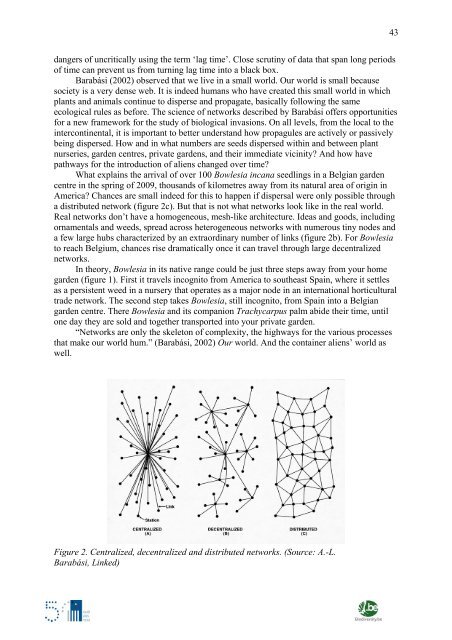Science Facing Aliens - Invasive Alien Species in Belgium - Belgian ...
Science Facing Aliens - Invasive Alien Species in Belgium - Belgian ...
Science Facing Aliens - Invasive Alien Species in Belgium - Belgian ...
You also want an ePaper? Increase the reach of your titles
YUMPU automatically turns print PDFs into web optimized ePapers that Google loves.
dangers of uncritically us<strong>in</strong>g the term ‘lag time’. Close scrut<strong>in</strong>y of data that span long periods<br />
of time can prevent us from turn<strong>in</strong>g lag time <strong>in</strong>to a black box.<br />
Barabási (2002) observed that we live <strong>in</strong> a small world. Our world is small because<br />
society is a very dense web. It is <strong>in</strong>deed humans who have created this small world <strong>in</strong> which<br />
plants and animals cont<strong>in</strong>ue to disperse and propagate, basically follow<strong>in</strong>g the same<br />
ecological rules as before. The science of networks described by Barabási offers opportunities<br />
for a new framework for the study of biological <strong>in</strong>vasions. On all levels, from the local to the<br />
<strong>in</strong>tercont<strong>in</strong>ental, it is important to better understand how propagules are actively or passively<br />
be<strong>in</strong>g dispersed. How and <strong>in</strong> what numbers are seeds dispersed with<strong>in</strong> and between plant<br />
nurseries, garden centres, private gardens, and their immediate vic<strong>in</strong>ity? And how have<br />
pathways for the <strong>in</strong>troduction of aliens changed over time?<br />
What expla<strong>in</strong>s the arrival of over 100 Bowlesia <strong>in</strong>cana seedl<strong>in</strong>gs <strong>in</strong> a <strong>Belgian</strong> garden<br />
centre <strong>in</strong> the spr<strong>in</strong>g of 2009, thousands of kilometres away from its natural area of orig<strong>in</strong> <strong>in</strong><br />
America? Chances are small <strong>in</strong>deed for this to happen if dispersal were only possible through<br />
a distributed network (figure 2c). But that is not what networks look like <strong>in</strong> the real world.<br />
Real networks don’t have a homogeneous, mesh-like architecture. Ideas and goods, <strong>in</strong>clud<strong>in</strong>g<br />
ornamentals and weeds, spread across heterogeneous networks with numerous t<strong>in</strong>y nodes and<br />
a few large hubs characterized by an extraord<strong>in</strong>ary number of l<strong>in</strong>ks (figure 2b). For Bowlesia<br />
to reach <strong>Belgium</strong>, chances rise dramatically once it can travel through large decentralized<br />
networks.<br />
In theory, Bowlesia <strong>in</strong> its native range could be just three steps away from your home<br />
garden (figure 1). First it travels <strong>in</strong>cognito from America to southeast Spa<strong>in</strong>, where it settles<br />
as a persistent weed <strong>in</strong> a nursery that operates as a major node <strong>in</strong> an <strong>in</strong>ternational horticultural<br />
trade network. The second step takes Bowlesia, still <strong>in</strong>cognito, from Spa<strong>in</strong> <strong>in</strong>to a <strong>Belgian</strong><br />
garden centre. There Bowlesia and its companion Trachycarpus palm abide their time, until<br />
one day they are sold and together transported <strong>in</strong>to your private garden.<br />
“Networks are only the skeleton of complexity, the highways for the various processes<br />
that make our world hum.” (Barabási, 2002) Our world. And the conta<strong>in</strong>er aliens’ world as<br />
well.<br />
Figure 2. Centralized, decentralized and distributed networks. (Source: A.-L.<br />
Barabási, L<strong>in</strong>ked)<br />
43


